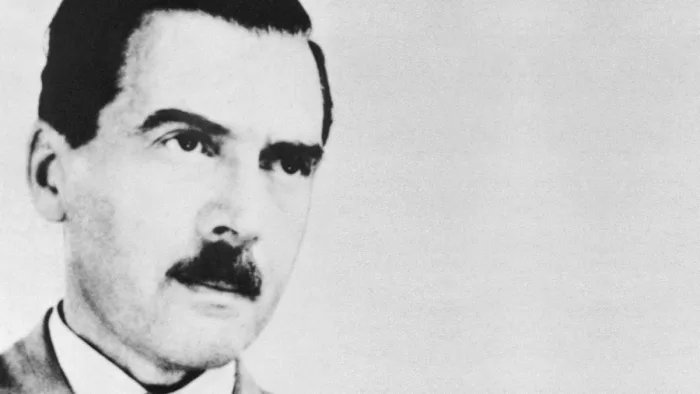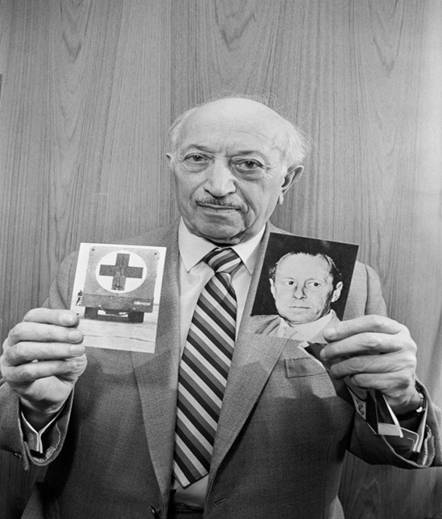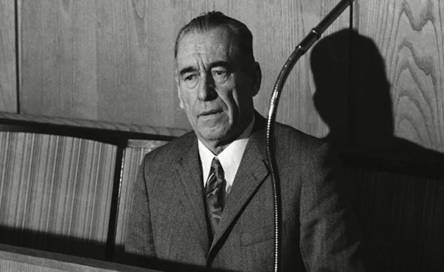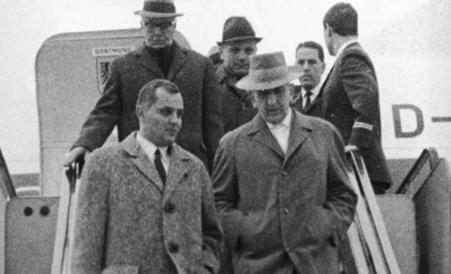|
|
"Buffalo
Bob" |
|
|
October 2022 Casale's Corner Held for the purpose of bringing Nazi war criminals to justice, the
Nuremberg trials were a series of 13 trials carried out in Nuremberg,
Germany, between 1945 and 1949. The defendants, who included Nazi Party
officials and high-ranking military officers along with German
industrialists, lawyers, and doctors, were indicted on such charges as
crimes against peace and crimes against humanity. Nazi leader Adolf Hitler (1889-1945) committed suicide and was never
brought to trial. Although the legal justifications for the trials and
their procedural innovations were controversial at the time, the
Nuremberg trials are now regarded as a milestone toward the
establishment of a permanent international court, and an important
precedent for dealing with later instances of genocide and other crimes
against humanity. Shortly
after Adolf Hitler came to power as chancellor of Germany in 1933, he
and his Nazi government began implementing policies designed to
persecute German-Jewish people and other perceived enemies of the Nazi
state. Over the next decade, these policies grew increasingly repressive
and violent and resulted, by the end of World War II (1939-45), in the
systematic, state-sponsored murder of some 6 million European Jews
(along with an estimated 4 million to 6 million non-Jews). There
were many legal and procedural difficulties to overcome in setting up
the Nuremberg trials. First, there was no precedent for an international
trial of war criminals. There were earlier instances of prosecution for
war crimes, such as the execution of Confederate army officer Henry Wirz
(1823-65) for his maltreatment of Union prisoners of war during the American Civil
War (1861-65); and the courts-martial held by Turkey in 1919-20
to punish those responsible for the Armenian genocide of 1915-16.
However, these were trials conducted according to the laws of a single
nation rather than, as in the case of the Nuremberg trials, a group of
four powers (France, Britain, the Soviet Union and the U.S.) with
different legal traditions and practices. The
Allies eventually established the laws and procedures for the Nuremberg
trials with the London Charter of the International Military Tribunal (IMT),
issued on August 8, 1945. Among other things, the charter defined three
categories of crimes: crimes against peace (including planning,
preparing, starting or waging wars of aggression or wars in violation of
international agreements), war crimes (including violations of customs
or laws of war, including improper treatment of civilians and prisoners
of war) and crimes against humanity (including murder, enslavement or
deportation of civilians or persecution on political, religious or
racial grounds). It was determined that civilian officials as well as
military officers could be accused of war crimes. The
city of Nuremberg (also known as Nurnberg) in the German state of
Bavaria was selected as the location for the trials because its Palace
of Justice was relatively undamaged by the war and included a large
prison area. Additionally, Nuremberg had been the site of annual Nazi
propaganda rallies; holding the postwar trials there marked the symbolic
end of Hitler's government, the Third Reich. The Major War Criminals' Trial: 1945-46 The
best-known of the Nuremberg trials was the Trial of Major War Criminals,
held from November 20, 1945, to October 1, 1946. The format of the trial
was a mix of legal traditions: There were prosecutors and defense
attorneys according to British and American law, but the decisions and
sentences were imposed by a tribunal (panel of judges) rather than a
single judge and a jury. The chief American prosecutor was Robert H.
Jackson (1892-1954), an associate justice of the U.S. Supreme
Court. Each of the four Allied powers supplied two judges-a main
judge and an alternate. Twenty-four
individuals were indicted, along with six Nazi organizations determined
to be criminal (such as the "Gestapo," or secret state police). One
of the indicted men was deemed medically unfit to stand trial, while a
second man killed himself before the trial began. Hitler and two of his
top associates, Heinrich Himmler (1900-45) and Joseph
Goebbels (1897-45), had each committed suicide in the spring of
1945 before they could be brought to trial. The defendants were allowed
to choose their own lawyers, and the most common defense strategy was
that the crimes defined in the London Charter were examples of ex post
facto law; that is, they were laws that criminalized actions committed
before the laws were drafted. Another defense was that the trial was a
form of victor's justice-the Allies were applying a harsh standard
to crimes committed by Germans and leniency to crimes committed by their
own soldiers. As
the accused men and judges spoke four different languages, the trial saw
the introduction of a technological innovation taken for granted today:
instantaneous translation. IBM provided the technology and recruited men
and women from international telephone exchanges to provide on-the-spot
translations through headphones in English, French, German and Russian. In
the end, the international tribunal found all but three of the
defendants guilty. Twelve were sentenced to death, one in absentia, and
the rest were given prison sentences ranging from 10 years to life
behind bars. Ten of the condemned were executed by hanging on October
16, 1946. Hermann Göring (1893-1946), Hitler's designated successor
and head of the "Luftwaffe" (German air force), committed suicide
the night before his execution. He was able to do this using a cyanide
capsule he had hidden in a jar of skin medication. Following
the Trial of Major War Criminals, there were 12 additional trials held
at Nuremberg. These proceedings, lasting from December 1946 to April
1949, are grouped together as the Subsequent Nuremberg Proceedings. They
differed from the first trial in that they were conducted before U.S.
military tribunals rather than the international tribunal that decided
the fate of the major Nazi leaders. The reason for the change was that
growing differences among the four Allied powers had made other joint
trials impossible. The subsequent trials were held in the same location
at the Palace of Justice in Nuremberg. These
proceedings included the Doctors Trial (December 9, 1946-August 20,
1947), in which 23 defendants were accused of crimes against humanity,
including medical experiments on prisoners of war. In the Judges Trial
(March 5-December 4, 1947), 16 lawyers and judges were charged with
furthering the Nazi plan for racial purity by implementing the eugenics
laws of the Third Reich. Other subsequent trials dealt with German
industrialists accused of using slave labor and plundering occupied
countries; high-ranking army officers accused of atrocities against
prisoners of war; and SS officers accused of violence against
concentration-camp inmates. Of the 185 people indicted in the subsequent
Nuremberg trials, 12 defendants received death sentences, 8 others were
given life in prison and an additional 77 people received prison terms
of varying lengths, according to the USHMM. Authorities later reduced a
number of the sentences. Aftermath The
Nuremberg trials were controversial even among those who wanted the
major criminals punished. Harlan Stone (1872-1946), chief justice of the
U.S. Supreme Court at the time, described the proceedings as a
"sanctimonious fraud" and a "high-grade lynching party." William
O. Douglas (1898-1980), then an associate U.S. Supreme Court justice,
said the Allies "substituted power for principle" at Nuremberg. Nonetheless,
most observers considered the trials a step forward for the
establishment of international law. The findings at Nuremberg led
directly to the United Nations Genocide Convention (1948) and Universal
Declaration of Human Rights (1948), as well as the Geneva
Convention on the Laws and Customs of War (1949). In addition,
the International Military Tribunal supplied a useful precedent for the
trials of Japanese war criminals in Tokyo (1946-48); the 1961 trial of
Nazi leader Adolf Eichmann (1906-62); and the establishment of tribunals
for war crimes committed in the former Yugoslavia (1993) and in Rwanda
(1994). The 7 Most Notorious Nazis Who Escaped to South America
Argentina,
for one, was already home to hundreds of thousands of German immigrants
and had maintained close ties to Germany during the war. After 1945,
Argentine President Juan Perón, himself drawn to fascist ideologies,
enlisted intelligence officers and diplomats to help establish "rat
lines," or escape routes via Spanish and Italian ports, for many in
the Third
Reich. Also giving aid: the Vatican in
Rome, which in seeking to help Catholic war refugees also facilitated
fleeing Nazis—sometimes knowingly, sometimes not. As
thousands of Nazis and their collaborators poured into the continent, a
sympathetic and sophisticated network developed, easing the transition
for those who came after. While no definitive evidence exists that
Hitler himself escaped his doomsday bunker and crossed the ocean, such a
network could have helped make it possible. Below,
a list of some of the most notorious Nazi war criminals who made their
way to South America. 1.
Adolf Eichmann WHAT
HE'S INFAMOUS FOR: The "world's most wanted Nazi," Eichmann was
the architect of Hitler's "Final Solution" to exterminate the Jews
from Europe. The notorious SS lieutenant
colonel masterminded the Nazi network of death camps that resulted in
the murder of approximately 6 million people. Eichmann orchestrated the
identification, assembly and transportation of European Jews to Auschwitz,
Treblinka and other death camps in German-occupied Poland. HIS
PATH TO SOUTH AMERICA: After World War II ended, Eichmann went into
hiding in Austria. With the aid of a Franciscan monk in Genoa, Italy, he
obtained an Argentine visa and signed an application for a falsified Red
Cross passport. In 1950 he boarded a steamship to Buenos Aires under the
alias Ricardo Klement. Eichmann lived with his wife and four children in
a middle-class Buenos Aires suburb and worked in a Mercedes-Benz
automotive plant. HOW
HE WAS BROUGHT TO JUSTICE: Israeli Mossad agents captured Eichmann in a daring
operation on May 11, 1960, then snuck him out of the country by
doping and disguising him as an El Al flight crew member. In Israel,
Eichmann stood trial as a war criminal responsible for deporting Jews to
death and concentration camps. He was found guilty after a four-month
trial in Jerusalem and received the only
death sentence ever issued by an Israeli court. He was hanged
on May 31, 1962. WHAT
HE'S INFAMOUS FOR: Second only to Eichmann as a target of Nazi
hunters, the doctor nicknamed the "Angel
of Death" conducted macabre experiments among the prisoners
at the Auschwitz death camp. An SS officer, Mengele was sent at the
start of World War II to the eastern front to repel the Soviets and
received an Iron Cross for his bravery and service. After being wounded
and declared unfit for active duty, he was assigned to the Auschwitz
death camp. There, he used the prisoners—particularly twins, pregnant
women and the disabled—as human guinea pigs. Mengele even tortured and
killed children with his medical experiments.
Dr.
Josef Mengele In Paraguay, 1960. Nicknamed the "angel of death," he
is infamous for conducting macabre experiments on pregnant women, twins
and others at the Auschwitz death camp. He eluded capture in South
America for 30 years. (Credit: Bettmann Archive/Getty Images) HIS
PATH TO SOUTH AMERICA: After World War II, Mengele spent three-plus
years in hiding in Germany. In 1949, with the help of a Catholic clergy
member, the "Angel of Death" fled via Italy to Argentina where he
owned a mechanical equipment shop and remarried under his own name in
Uruguay in 1958. The doctor lived in various Buenos Aires suburbs, but
after hearing of Eichmann's capture, went underground, first in
Paraguay, then in Brazil. HOW
HE ELUDED JUSTICE: West Germany had sent an extradition request to
Argentina, which dragged its feet, claiming a review was necessary
because the doctor's crimes had been "political." Nazi hunters
pursued him for decades, but Mengele ultimately
drowned off the Brazilian coast in 1979, felled by a stroke.
Because he had operated under an assumed name in Brazil, his death
wasn't verified until his remains were forensically tested in 1985. 3.
Walter Rauff WHAT
HE'S INFAMOUS FOR: An SS colonel, Rauff was instrumental in the
construction and implementation of the mobile gas chambers responsible
for killing an estimated 100,000 people during World War II. According
to the United Kingdom's MI5 intelligence agency, Rauff oversaw the
modifications of trucks that diverted their exhaust fumes into airtight
chambers in the back of vehicles capable of carrying as many as 60
people. The trucks were driven to burial sites, and along the way
victims would be poisoned and/or asphyxiated from the carbon monoxide.
After persecuting Jews in Vichy France-controlled Tunisia during 1942
and 1943, Rauff oversaw Gestapo operations in northwest Italy. There, as
in Tunisia, Rauff gained a "reputation for utter ruthlessness,"
infamous for the indiscriminate execution of both Jews and local
partisans. HIS
PATH TO SOUTH AMERICA: Allied troops arrested Rauff at the end of the
war. He escaped from an American POW camp and hid in Italian convents.
After serving as a military adviser to the president of Syria in 1948,
he fled back to Italy and escaped to Ecuador in 1949 before settling in
Chile where he lived under his own name. HOW
HE ELUDED JUSTICE: Never captured, Rauff worked as a manager of a king
crab cannery and actually spied for West Germany between 1958 and 1962.
His whereabouts became known after he sent a letter requesting that his
German naval pension be sent to his new address in Chile. He was
arrested in 1962 in Chile but freed by the country's supreme court the
following year. Chilean dictator Augusto Pinochet repeatedly resisted
calls from West Germany for Rauff's extradition. The Nazi died in
Chile in 1984. German and Chilean mourners at his funeral gave Nazi
salutes and chanted "Heil Hitler."
Nazi
hunter Simon Wiesenthal holding photographs depicting former Gestapo
chief Walter Rauff and a mobile gas-chamber van he created to execute
Jews. Rauff was protected from prosecution by Chilean president Augusto
Pinochet. (Credit: Bettmann Archive/Getty Images) 4.
Franz Stangl WHAT
HE'S INFAMOUS FOR: Nicknamed the "White Death" for his proclivity
to wear a white uniform and carry a whip, the Austrian-born Stangl
worked on the Aktion T-4 euthanasia program under which the Nazis killed
those with mental and physical disabilities. He later served as the
commandant of the Sobibor and Treblinka death camps in German-occupied
Poland. More than 100,000 Jews are believed to have been murdered during
his tenure at Sobibor before he moved to Treblinka, where he was
directly responsible for the Nazis' second-deadliest camp where
900,000 were killed. HIS
PATH TO SOUTH AMERICA: After the end of the war, Stangl was captured by
the Americans but escaped to Italy from an Austrian prison camp in 1947.
Assisted by the Nazi-sympathizing Austrian bishop Alois Hudal, Stangl
traveled to Syria on a Red Cross passport before sailing to Brazil in
1951. HOW
HE WAS CAPTURED: He was employed by Volkswagen in São Paulo under his
own name when he was arrested in 1967 after being tracked down by Simon
Wiesenthal, a Holocaust survivor and well-known Nazi hunter. Extradited
to West Germany, Stangl was tried and found guilty of the mass murder of
900,000 people. Sentenced to life imprisonment, he died of heart failure
in 1971.
Franz
Stangl, former SS commander of Treblinka extermination camp in
German-occupied Poland, hearing his life-in-prison sentence in
Dusseldorf. Stangl was found responsible for the death of hundreds of
thousands of Jews. (Credit: Heinz Ducklau/AP/REX/Shutterstock) 5.
Josef Schwammberger WHAT
HE'S INFAMOUS FOR: An Austrian Nazi, Schwammberger was an SS
commandant in charge of three labor camps in the Jewish ghettoes of
Nazi-occupied Poland during World War II. Brandishing a horsewhip and a
German Shepherd trained to attack people, he arrived in 1942 at the
Rozwadów forced-labor camp, where prisoners died by the hundreds, many
shot by Schwammberger himself. In 1943, he organized the mass execution
of 500 Jewish prisoners at the Przemyśl camp. He personally
executed 35 people at Przemyśl, shooting them in the back of the
neck, and dispatched Jews to the Auschwitz death camp. In Mielec in
1944, he cleansed the city of Jews. "His path was littered with
corpses," said the Nazi hunter Simon Wiesenthal. HIS
PATH TO SOUTH AMERICA: Arrested in Austria in 1945, Schwammberger
escaped to Italy in 1948 and months later arrived in Argentina, where he
lived openly under his own name and obtained citizenship. HOW
HE WAS CAPTURED: Sought by West Germany for extradition in 1973,
Schwammberger went into hiding but was eventually arrested by Argentine
officials in 1987 after an informant responded to the German
government's $300,000 reward. He returned to West Germany in 1990 to
stand trial. Witnesses at the trial said they had seen Schwammberger
throw prisoners onto bonfires, kill Jews kneeling beside mass graves and
slam children's heads against walls "because he didn't want to
waste a bullet on them." In 1992, he was found guilty of seven counts
of murder and 32 cases of accessory to murder and sentenced to life
imprisonment. Schwammberger died in prison in 2004 at the age of 92.
WHAT
HE'S INFAMOUS FOR: A mid-level SS commander and member of the Gestapo,
Priebke participated in the 1944 Ardeatine Caves massacre in Rome in
which the Nazis slaughtered 335 people in retaliation for the killing of
33 German SS members by Italian partisans. Priebke admitted killing two
of the Italians, but claimed he was only following orders. Priebke also
signed off on the transport of 2,000 Roman Jews to Auschwitz and served
as the Nazi go-between with the Vatican. HIS
PATH TO SOUTH AMERICA: Priebke escaped from a British prisoner of war
camp on New Year's Eve in 1946 by cutting through barbed wire while
his guards were drunk. With the help of Bishop Alois Hudal, Priebke fled
to Argentina on a falsified Red Cross passport in 1948. He settled in
the idyllic mountain town of San Carlos de Bariloche in the Patagonia
region, where he operated at a Viennese deli and worked at a German
school, living under his own name. HOW
HE WAS CAPTURED: In 1994, Priebke's past was revealed to the world
after an ambush interview by ABC newsman Sam Donaldson. As a result of
the uproar following the interview, Priebke was extradited to Italy
where he was convicted of war crimes and sentenced to life imprisonment,
to be served under house arrest. Priebke died in 2013 at the age of 100.
His funeral resulted in a clash between fascist and anti-fascist
protestors, and he was buried in a secret location after Argentina
refused to have him interred on its soil. WHAT
HE'S INFAMOUS FOR: A lawyer and SS officer, Bohne headed the Third
Reich's Work Group of Sanatoriums and Nursing Homes and was
responsible for the administrative logistics of Hitler's Aktion T-4
euthanasia program. Claiming to be a "mercy killer," Bohne was
instead among the leaders who carried out a systemic extermination in
order to purify the Aryan race and avoid state expenditures on those
with mental and physical disabilities. All told, the program killed some
200,000 Germans with incurable diseases, mental illnesses and other
handicaps. The victims were led to gas chambers in the institutions and
then cremated. The program served as a trial run for the mass
extermination camps later operated by the SS. Bohne was thrown out of
the Nazi Party after submitting a report accusing his agency of fraud
and corruption. HIS
PATH TO SOUTH AMERICA: Bohne fled to Argentina in 1949 disguised as a
"technician" for the military under the country's president, Juan
Perón. He later admitted that Perón's helpers gave him "money and
identify papers." HOW
HE WAS CAPTURED: After a coup deposed Perón, Bohne returned to Germany
and was indicted by a court in Frankfurt in 1963. Released on bail,
Bohne once again fled to Argentina from where he was finally extradited
three years later as the first Nazi criminal surrendered by Argentina.
Declared unfit to stand trial, Bohne survived another 15 years before
his death in 1981. Did
you know? The death sentences imposed in October 1946 were carried out
by Master Sergeant John C. Woods (1903-50), who told a reporter from
Time magazine that he was proud of his work. "The way I look at
this hanging job, somebody has to do it . . . 10 men in 103 minutes.
That's fast work."
|
||







